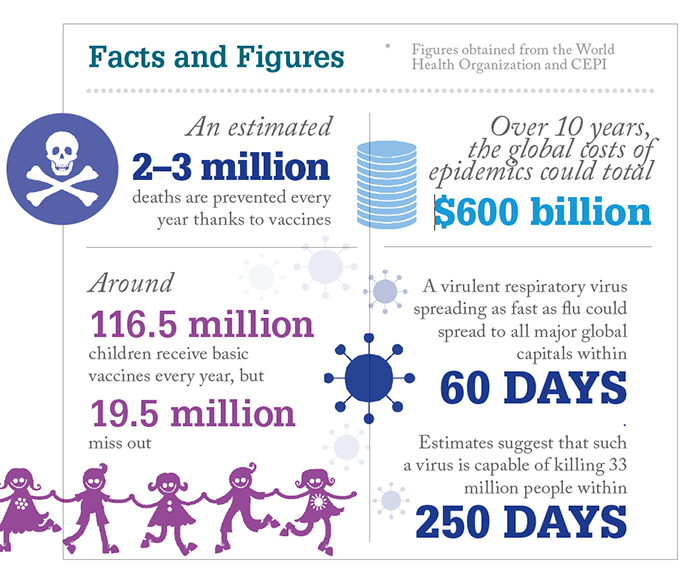Vaccines are one of the greatest public health achievements
I’ve been working in life sciences since my undergraduate days, starting with a human biology degree at Stanford University, California. Following business school, I worked for Novartis for a number of years covering different roles that took me from Switzerland to the US, and from marketing to R&D. Then an opportunity opened up to enter the vaccines space. Novartis acquired Chiron for their vaccine work and wanted to open up a vaccine division; I was offered a position and ended up loving it. The passion of the team working in that space and the impact your work can have on patients is unparalleled. When working with vaccines, you are combating powerful diseases and working to strengthen public health, which are powerful drivers for motivation. At Novartis, I had previously worked in hypertension. High-blood pressure kills many people, but each new drug is only usually marginally better than the previous one. Having the opportunity to develop an entirely new vaccine, which could substantially change disease and health rather than incrementally managing it, is exhilarating. It really gets into your blood (no pun intended!) and I have never looked back.Manufacturing challenges are significant
As fulfilling as working with vaccines is, there are definitely many unique challenges. The first, and most obvious, challenge is the significant safety hurdles you have to jump over. Vaccines are given to healthy people and there can be no severe side effects. Imagine developing a new pediatric vaccine that you aim to give to 4 million healthy American babies every year – no one will agree to the vaccination if there are any health risks. A second challenge is scale of production. Whereas a chemotherapy drug may reach production levels of 10,000-30,000 doses per year, vaccines need to be produced to the tune of over one million doses per year – seasonal flu vaccines can even reach the scale of 70 million doses. Being able to get your costs to a reasonable level per dose is essential – and there are many potential vaccines that have never seen the light of day because it would be impossible to manufacture them cost effectively at the necessary scale.Vaccines are not always appreciated by the public
Governments, payers and individuals do not seem to have the same willingness to pay for new vaccines as they would new drugs. I think it’s partially psychology; we humans invariably wait for a problem to emerge before dealing with it, rather than taking steps to avoid it. There is also the concept that vaccines are a right and a public good, and therefore the price needs to be as low as absolutely possible (which I certainly do not disagree with). Very low vaccine prices, however, lead to less innovation. For example, even large-scale products, like seasonal flu vaccines, still use egg techniques that have been around for over 70 years. Of course, this doesn’t mean there is no innovation – there are exciting technologies in use such as virus-like particles (VLPs), which enable vaccines to be developed without any living virus. Companies are also focusing on vector vaccines, although none of these are yet on the market. In comparison to pharma fields, however, vaccines still have a lot of room for growth. The anti-vaccine movement can also have an impact on public perception of vaccines. Anti-vaxers generally target high-profile vaccines rather than smaller, specialty ones, but they have a noticeable effect – the immunization rate in Marin County, California, is lower than some countries in the developing world. As an industry, we haven’t done much to combat the impact of anti-vaxers, but there have been huge debates between public health leaders, academics, and pharma companies about how to tackle the issue. Do we engage, or do we ignore them and remain silent? It’s a tough debate, but undoubtedly public health is being damaged.Market gaps allows smaller vaccine players to succeed
Big pharma is consolidating its vaccine efforts. Novartis, for example, sold its vaccines business to GlaxoSmithKline in 2015. Today, there are only a handful of big pharma companies working with vaccines and most tend to focus on the bigger opportunities; the routinely used vaccines sold at large scale. Smaller, specialty vaccines, such as vaccines for travelers, the military, and the developing world, are being neglected, which could ultimately impact the developed world (consider Ebola). After leaving Novartis in 2011, I joined PaxVax, which focuses on providing vaccines in underserved markets. At first, PaxVax was based on a more traditional biotech structure, focusing on the technology around vectors to develop new vaccines – many of which can be found in the clinic today. But, along the way, we had a bit of a pivot while working on new technologies. It was frustrating to see so many diseases being overlooked and we started to pay greater attention to specialty vaccines. Our journey began when we licensed CVD 103 HgR from UMB and then developed Vaxchora, a vaccine for cholera, approved by the FDA in 2016.We also spotted an opportunity with Johnson & Johnson’s typhoid vaccine, Vivotif. The vaccine was similar to Vaxchora – both are live attenuated oral vaccines. We were able to acquire Vivotif and J&J’s manufacturing facility in Switzerland, which was a great opportunity for us; it gave us access not only to high capacity but also to a team well used to FDA and European inspections – extremely valuable for a small company just entering the market. Today, Vaxchora and Vivotif are commercially available in the US, and Vivotif is also commercially available in Europe. We’ve ramped up our R&D pipeline to include vaccines for chikungunya, Zika, hepatitis A and HIV. We also co-promote some smaller products for other partners in Europe. It’s actually quite unusual for a small company to manufacture and commercialize their own products; many instead look for partners. But there is a danger: your commercial partner may not be as interested in your product as they are in their own portfolio. And it’s very easy for niche products to get lost in a large portfolio. With J&J and Vivotif, for instance, we hypothesized that the product was largely being ignored in the larger suite of drug and vaccine opportunities because it was a specialty product. There are very few vaccine-focused companies out there, which is why I think there is a real market opportunity for a company like PaxVax! Small companies can be very successful in the vaccine space. Development costs can be lower for specialty indications, and as production is scaled down with specialty vaccines, manufacture is much easier. Building out a full manufacturing facility can be extremely challenging for a small company, but there are options out there; for example, we have used pod technologies – mobile suites – that enable us to get a GMP commercial production suite up and running really fast. They are only small scale, but very easy to roll out.Balancing global need, innovation, and cost is a challenge
A constant challenge is how we can support innovation in overlooked disease areas when prices are so low? For example, there is a global shortage of yellow fever vaccine in both the developing world, and for travelers from the developed world. We could develop a new yellow fever vaccine – current yellow fever vaccines are made with egg-based techniques, and we certainly have a few innovative ideas – but current vaccines cost around $2 per dose. Agencies don’t want to pay more, so how can we justify the costs of developing a new vaccine? Revenue opportunities aren’t huge for vaccines so it’s important to have multiple products. As we focus on overlooked diseases – which almost invariably affect the developing world – we are working to further reduce costs and overcome the cold-chain hurdle, among other things to better serve those regions.

Collaboration opens new doors
The US Department of Defense (DOD) is very interested in vaccines for neglected diseases because soldiers can also be affected – and medical supplies are limited on the battlefield. We currently have a number of partnerships with the DOD. One of our focuses is on chikungunya, a mosquito-borne viral infection. It’s a disease that has been infecting people in Sub-Saharan Africa and Asia for decades, more recently spreading to Brazil and the Caribbean. Similar to Zika, chikungunya is episodic – an outbreak may tear through a community, but be followed by a period of relative stagnation. Unfortunately, unlike Zika, an effort to find a vaccine for Chikungunya hasn’t really been a priority for the pharma industry. In collaboration with the DOD, and with technology licensed from the US National Institutes of Health (NIH), we have a chikungunya vaccine in phase II. We may also be able to do something with Zika. Our potential chikungunya vaccine uses VLP technology (many vaccines in our pipeline focus on VLPs), and we are seeing some interesting pre-clinical results by partnering VLPs with Zika antigens. We are working with the Centers for Disease Control and Prevention (CDC) on further development. Smaller companies will always be limited by resources, rather than the number of opportunities. Working with groups like the DOD, NIH, and CDC are part of the benefits of working with vaccines – the public health infrastructure really helps provide valuable scientific input, as well as helping to integrate costs. I believe that collaboration is crucial to overcome the challenges of working in the vaccine space. At the World Economic Forum in January 2016, a new public health alliance launched, called the Coalition for Epidemic Preparedness Innovations (CEPI). CEPI was founded by the World Economic Forum, Wellcome Trust, the Bill & Melinda Gates Foundation, and the governments of India, and Norway, to prepare for the next potential waves of infectious diseases that could affect public health and to develop new vaccines (1). CEPI helps bring priority vaccine candidates through to the end of phase II clinical trials and supports vaccine platforms that can be rapidly deployed against known and unknown pathogens. A few of the diseases identified as focus points are Lassa fever, Nipah, and MERS. Over 70 organizations are part of the initiative and I am a member of the board. With all of this collaborative power, we have to be able to make a difference. I truly believe that one day we will be able to prevent epidemics before they occur. Nima Farzan is CEO of PaxVax, California, USA.References
- CEPI, “Mission”, (2017). Available at: http://bit.ly/2yx6Ntu. Last accessed November 27, 2017.
